Kentucky Pesticide Safety Education Program

Questions?
Contact
Dr. Ric Bessin
Dept. of Entomology
University of Kentucky
859-257-7450
rbessin@email.uky.edu
Visits since 11/11/16
Diseases of Turfgrass
Accurate identification and diagnosis of plant diseases is an art, as well as a science, and experience is essential. This section will acquaint you with the general symptoms of diseases of turfgrass. For more accurate disease diagnosis, consult your county Extension agent.
Numerous disease problems occur on turfgrass in Kentucky and these frequently cause extensive damage. In many cases, a disease is blamed for poor quality turf when, in reality, it may be only a contributing factor or not involved at all. Frequently, dead and dying grass is caused by improper fertilization, chemical burn, mower problems, dog or insect injury, dry or wet spots, thatch, competition from other plants, or from any other improper management. Accurate diagnosis of the problem is essential for proper control.
Two types of pathogens (fungi and nematodes) are found in turf in Kentucky. Observation of symptoms is an important aid in determining which pathogen is causing a disease. The following information will explain the identification and biology of some common turf diseases.
Helminthosporium Leaf Spot
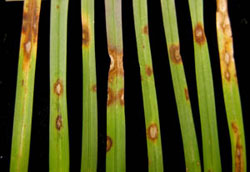
"Football" shaped leaf lesions of leaf spot and melting out of Kentucky bluegrass
photo: S. Tirpak, Rutgers
Helminthosporium leaf spot is a common disease problem of Kentucky bluegrass and is often referred to as "melting-out." Other Helminthosporium leaf spots are important on fescues and bermudagrass. From a distance, leaf spot-affected areas appear chlorotic or yellowed. Individual spots on the leaves have dark margins with tan centers. The spotting is most noticeable in spring and early summer.
Infection in the crown of the plant during the summer can lead to the death of plants (thus "melting-out"). Cool, wet weather during spring followed by drought during summer accentuates the damage from this disease.
Dollar Spot
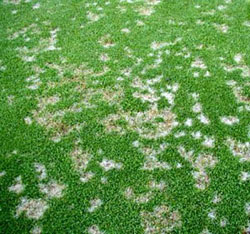
Dollar spot appears as sunken round, bleached-out or straw-colored spots.
photo: Michigan State Plant Pathology
Dollar spot affects a wide variety of grasses, including Kentucky bluegrass, bermuda, perennial ryegrass, zoysia, tall fescue, and bentgrasses. The fungus is active throughout the growing season, especially when there is low soil moisture and an excess of dew or fog. It is most prevalent in the spring.
The disease is characterized by small white patches, one to three inches in diameter A large number of spots can come together and form larger dead areas. Leaf spots are usually found along the edges of the grass blade and may come together across the blade, causing the tip to die. Individual leaf spots are tan with reddish margins.
Pythium Blight
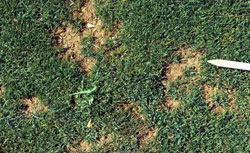
Pythium blight
photo: William M. Brown, Jr., Bugwood.org
Pythium blight is caused by a number of species of the fungus Pythium. The fungus primarily attacks perennial ryegrass and bentgrass although other grasses can be affected. Conditions that favor Pythium blight include abundant moisture and poor air circulation. The disease is most active in hot, humid weather when the night temperature does not go below 70°F.
The blight appears first as small spots a few inches in diameter. Diseased leaves are at first water-soaked, soft, and slimy, and may mat together. Dense, cottony fungal growths often are apparent in affected areas during a heavy dew. The leaves soon shrivel and the color of the patch soon fades to light brown as dew dries. The shape of the diseased area may be streaked following the drainage flow of water over the turf.
Brown Patch
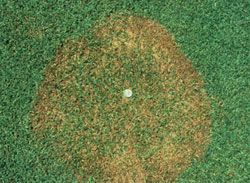
Brown patch on bentgrass
photo: U Mass
Brown patch is a common fungal disease of fescues, perennial ryegrass and bentgrass. It develops most readily when daytime highs exceed 80°F and nighttime lows are in the mid- 60's°F or higher.
Brown patch is one of the more common turf diseases, especially in tall fescue. In addition to ideal temperatures and humid weather, heavy applications of nitrogen fertilizer favor disease development.
Brown patch is characterized by nearly circular areas of dead leaves that may be a few inches to several feet in diameter. On closely mown turf, the edges of the dead area may have a gray, smoky color, particularly in early morning. Affected areas are generally tan or brownish in bent and ryegrass. Affected fescues usually have straw-colored leaves.
Summer Patch
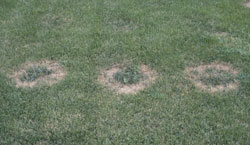
Summer Patch
photo: Mary Ann Hansen, Virginia Polytechnic Institute and State University, Bugwood.org
Summer patch affects Kentucky bluegrass and annual bluegrass. Circular to irregular patches of dead turf up to 1-2 feet in diameter develop during hot weather in mid- to late-summer. Below ground, roots and crowns of affected plants are brown and decayed, a result of fungal colonization. A tuft of healthy, green grass is sometimes evident in the center of affected patches, giving them a characteristic "donut" appearance.
Necrotic Ring Spot
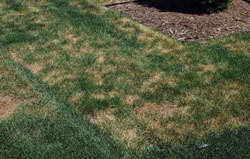
Necrotic Ring Spot
photo: Howard F. Schwartz, Colorado State University, Bugwood.orgg
Necrotic ring spot is another disease of bluegrasses with symptoms similar to summer patch. In contrast to summer patch, symptoms of necrotic ring spot can develop following cool, wet weather in late spring or mid-autumn. Necrotic ring spot is less common in Kentucky than summer patch.
Rust
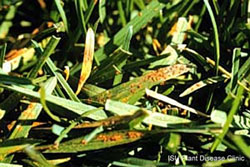
Rust pustules on turfgrass
photo: Iowa State
Rust is sometimes a problem on Kentucky bluegrass, fescue, zoysia, perennial ryegrass, and bermuda grasses. Rust infection results from rust spores which are blown to the plant from distant areas or from nearby alternate hosts. Large numbers of spores are produced in the leaf spot (pustule). These spores are then the source of new infections.
The disease is most frequently found during cool, humid weather during autumn. Grass varieties differ in susceptibility to rust.
Red Thread
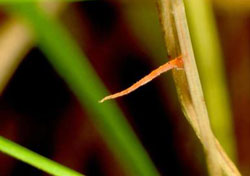
Red thread
photo: Bruce Watt, University of Maine, Bugwood.org
Red thread is seen as irregularly shaped patches of blighted turfgrass, ranging from a few inches to a few feet in diameter. Often, as diseased leaves turn brown, pink or reddish fungal growth can be observed on the leaf surface or emerging from the cut ends of leaves. This disease affects most of the common grasses grown in Kentucky and is often found during spring and early summer. The disease is favored by conditions of low nitrogen fertility.
Mushroom Fairy Ring
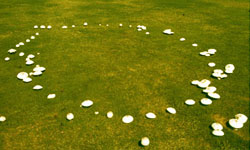
Mushroom fairy ring
photo: Clemson University - USDA Cooperative Extension Slide Series, Bugwood.org
Mushroom fairy ring can occur in any turf. The ring appears as a circular discoloration of grass from several inches to many yards in diameter. Mushrooms (toadstools) may appear at the edge of the ring during warm, moist periods).
The ring of grass is generally a darker green than the grass inside and outside the ring. During periods of moisture stress, the grass inside the ring may die. This general decline of grass inside the ring adds to the unsightliness of the fairy ring problem. Fairy rings gradually increase in size.
Slime Molds
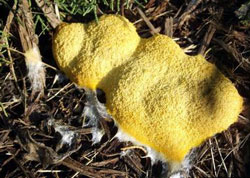
Dog vomit slime mold
photo: Sandra Jensen, Cornell University, Bugwood.org
Slime molds are commonly found on lawns in warm, moist weather. This fungal growth on grass leaves may be either a small, crust-like, light to dark mass with a sooty appearance, or a tan to orange shapeless mass.
The fungus causing this unsightly problem does not infect the grass blade; it simply uses it for support. The only effect it has on the plant is to temporarily reduce food production by the grass leaf as a result of shading.
Nematodes
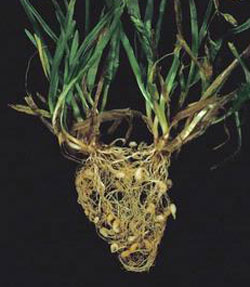
Root-gall nematodes on Kentucky bluegrass
photo: Bonsak Hammeraas, NIBIO - The Norwegian Institute of Bioeconomy Research, Bugwood.org
Nematodes weaken and reduce the vigor of turfgrass by restricting the development of the root system. The symptoms of nematode injury may be confused with nutritional problems, insufficient water, hardpan, or any factor that restricts root development.
Symptoms commonly associated with nematode injury include thinned or completely killed areas, pale green to chlorotic color, excessive wilting during drought stress, poor response to fertilization, and a greater weed problem due to sparse grass.
The intensity of the symptoms will vary with the grass variety, the kinds of nematodes present, the nematode population level, and the fertilization-watering program being practiced. The most reliable method for determining whether a nematode problem exists is by a soil assay. Nematode damage to turfgrass is uncommon in Kentucky.
1) Which of the following causes a plant disorder?
2) _________ are the most common infectious organisms causing plant disease.3) _________ reproduce by spores.
4) _________ reproduce by simple cell division.
5) _________ is an example of a fungal disease.
6) ________ diseases are commonly spread by aphids or leafhoppers.
7) Wilting is an example of a disease sign.
8) Infection begins when the pathogen ___________.
9) _________ move from plant to plant on in water droplets, rain splash, or being carried by insects.
10) Powdery mildew, root rots, and stem rots are examples of diseases caused by __________.
11) Most problems with dead and dying turfgrass grass are due to diseases.
12) From a distance, areas of turfgrass affected by ____________ appear chlorotic or yellowed; individual spots on the leaves have dark margins with tan centers.
13) __________ is characterized by small white patches, 1 to 3 inches in diameter that may join to form larger dead areas of turfgrass.
14) ___________ appears during hot weather in mid- to late-summer as circular to irregular patches of dead turf 1 to 2 feet in diameter.
15) _________ diseases usually produce pustules on plant leaves.
16) Leaf rust is rarely is an explosive problem because it develops so slowly.
17) _________ is the first step in disease management.
18) Many different plant diseases cause similar symptoms.
website content by L. Townsend website design by P. Dillon copyright © 2016 University of Kentucky Department of Entomology
University of Kentucky College of Agriculture |
S-225 Agricultural Science Center North, Lexington, KY 40546-0091 | 859.257.7450
An Equal Opportunity University |
Last modified
11/30/2018
